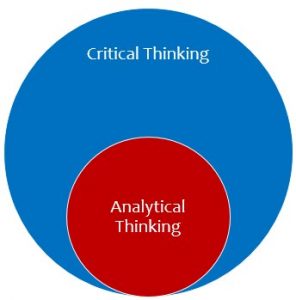Analytical Thinking and Critical Thinking
Some people assume that analytical thinking and critical thinking are one in the same. However, that is incorrect. Although there are similarities, there are distinct differences between the two.
Definitions:
Analytical thinking is the mental process of breaking down complex information or comprehensive data into fundamental parts or basic principles.
Critical thinking is the mental process of carefully evaluating information and determining how to interpret it in order to make a sound judgment.
Differences between Analytical Thinking and Critical Thinking
A basic difference between analytical thinking and critical thinking is analytical thinking involves breaking down complex information into smaller parts while critical thinking involves taking outside knowledge into account while evaluating information. Basically, analytical thinking seeks to review and breakdown the information gathered while critical thinking looks to make a holistic judgment using various sources of information including a person’s own existing knowledge.
Analytical thinking is more linear and step-by-step breakdown of information. On the other hand, critical thinking is more holistic as it seeks to assess, question, verify, infer, interpret, and formulate.
Analytical thinking can be thought of as a step in the critical thinking process. When you have a complex problem to solve, you would want to use your analytical skills before your critical thinking skills. Critical thinking does involve breaking down information into parts and analyzing the parts in a logical, step-by-step manner. However, it also involves taking other information to make a judgment or formulate innovative solutions.
Additionally, with analytical thinking, you use facts within the information gathered to support your conclusion. Conversely, with critical thinking, you make a judgment based on your opinion formed by evaluating various sources of information including your own knowledge and experiences.
Analytical Thinking and Critical Thinking
About Analytical Thinking
Analytical thinking uses a step-by-step method to analyze a problem or situation by breaking it down into smaller parts in order to come to a conclusion.
With analytical thinking, you make conclusions by breaking down complex information into smaller parts and analyzing the parts. You look for patterns and trends as well a cause and effect within the information in order to find connections between the parts. In the end, you make draw a conclusion based on the available facts.
Steps for Analytical Thinking
Analytical thinking begins by gathering all relevant information. You then break up large, complex data into smaller, more manageable sizes. You then examine each sub-part to understand its components and relationship to the larger more complex data. You compare sets of data from different sources by looking at the information through different points of view with the objective to understand how it connects to other information. You search for patterns, trends, and cause and effect. Finally, you draw appropriate conclusions from the information in order to arrive at appropriate solutions.
Analytical thinking involves:
- Gathering relevant information
- Focusing on facts and evidence
- Examining chunks of data or information
- Identifying key issues
- Using logic and reasoning to process information
- Separating more complex information into simpler parts
- Sub-dividing information into manageable sizes
- Finding patterns and recognizing trends
- Identify cause and effect
- Understanding connections and relationships
- Eliminating extraneous information
- Organizing Information
- Drawing appropriate conclusions
About Critical Thinking
Critical thinking employs logic and reasoning to come to a conclusion about how best to perceive and interpret information in order to make sound judgments.
With critical thinking, you make conclusions regarding your unique perception of the information. You look into other pieces of data that could be relevant. Then you combine your new information with your existing knowledge of the world in order to make the most accurate assessment. Essentially, you reflect upon information in order to form a sound judgment that reconciles scientific evidence with common sense. Ultimately, you make reasoned judgments that are logical and well thought out by assessing the evidence that supports a specific theory or conclusion.
Steps for Critical Thinking
Critical thinking involves gathering all relevant information, then evaluating the information to determine how it should be best interpreted. You evaluate information by asking questions, assessing value, and making inferences. You then formulate ideas and theories based on the evaluation. You consider outside information rather than sticking strictly with the information presented. You then consider alternative possibilities before reaching a well-reasoned conclusion. Finally, you test your conclusions in an attempt to verify if evidence supports your conclusions and make your judgment.
Critical thinking involves:
- Gathering relevant information
- Evaluating information
- Asking questions
- Assessing bias or unsubstantiated assumptions
- Making inferences from the information and filling in gaps
- Using abstract ideas to interpret information
- Formulating ideas
- Weighing opinions
- Reaching well-reasoned conclusions
- Considering alternative possibilities
- Testing conclusions
- Verifying if evidence/argument support the conclusions

